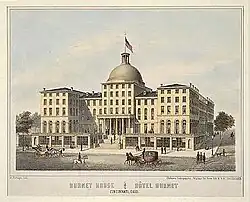| Burnet House | |
|---|---|
 Burnet House in Cincinnati, pictured 1850s | |
| General information | |
| Coordinates | 39°05′55″N 84°30′44″W / 39.0986°N 84.5123°W |
| Construction started | October 11, 1848 |
| Opened | May 3, 1850 |
| Demolished | 1926 |
| Design and construction | |
| Architect(s) | Isaiah Rogers |
Burnet House was a grand hotel that stood at the corner of Third and Vine in Cincinnati, Ohio in the United States from 1850 to 1926. In its day the Burnet hosted a multitude of dignitaries, including Abraham Lincoln (twice), Edward VII of the United Kingdom (when he was still Prince of Wales), and Jenny Lind.
History
The hotel was named for Jacob Burnet, a judge of the Ohio Supreme Court, who was an investor in the project and on whose land the hotel was constructed.[1][2] The developer was Abraham Coleman, a Cincinnati civic booster, who raised $2.5 million from 170 investors.[3] Isaiah Rogers, nationally acclaimed as a designer of elite hotels, was hired for $150,000.[3] Cincinnati was the sixth-largest city in the country when Burnet House opened in 1850;[2] the hotel became nationally acclaimed and was the state's premiere hotel well into the 1870s.[3] Burnet House was one of a handful of American hotels with a gilded dome.[4] Circa 1879 it had 240 guest rooms, as well as parlors, reading rooms, smoking rooms, billiard rooms, bath rooms, a bar and a restaurant.[5] According to one 20th-century history of American hotels the Burnet "out-gadgeted the hotels of New York and was as sumptuously furnished and had as great a layout of public rooms as any hotel of its day. It was, besides, the most distinguished hotel architecturally."[4]
The Burnet House was considered the city's leading Union hotel during the American Civil War, whereas the Spencer House (opened 1853) "was known as a 'Copperhead hotel'." The Spencer reportedly had a "large soundproof room for professional gamblers between their trips up and down the Ohio and Mississippi rivers. During the war this room is said to have been used for many secret meetings of Southern agents and leaders".[4] Some accounts have it that Sherman and Grant planned the former's March to the Sea at Burnet House, but similar claims have made about Galt House in Louisville (debunked), and locations in Chattanooga, Nashville, and Washington, D.C.[6][7] In later years a library at the hotel was home to "the library and portrait collection of the Loyal Legion, whose membership consisted of officers who served in the Union Army during the Civil War."[6]
See also
References
- ↑ Brown, Dale Patrick (2011). Literary Cincinnati: The Missing Chapter. Athens, Ohio: Ohio University Press. p. 61. ISBN 9780821444238.
- 1 2 Berger, Molly W. (2011). Hotel Dreams: Luxury, Technology, and Urban Ambition in America, 1829–1929. JHU Press. p. 147. ISBN 978-1-4214-0184-3.
- 1 2 3 Lindow, Blanche; Miller, Zane L. (May 1976). "Queen City History: The Burnet House Hotel and the Central Business District". Cincinnati Magazine. Emmis Communications. pp. 16–17.
- 1 2 3 Williamson, J. (1930). The American Hotel: An Anecdotal History. New York: Alfred A. Knopf. pp. 99–100. Retrieved 2023-11-07 – via HathiTrust.
- ↑ Kenny, Daniel J. (1879). Cincinnati illustrated: a pictorial guide to Cincinnati and the suburbs. Cincinnati: Robert Clarke & co. p. 57 – via HathiTrust.
- 1 2 Kesterman, Richard (Winter 2012). "Burnet House: A Grand Cincinnati Hotel Project". Ohio Valley History. Filson Historical Society and Cincinnati Museum Center. 12 (4): 60–68. eISSN 2377-0600. Retrieved 2023-07-02 – via Project MUSE.
- ↑ Bullard, Gabe (2014-03-16). "No, Ulysses S. Grant and William Tecumseh Sherman Didn't Plan the March to the Sea in Louisville". Louisville Public Media. Retrieved 2023-09-19.